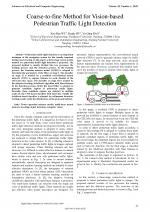| 1/2020 - 6 |
Coarse-to-fine Method for Vision-based Pedestrian Traffic Light DetectionWU, X.-H. |
| Extra paper information in |
| Click to see author's profile in |
| Download PDF |
Author keywords
gaussian mixture model, multi-layer neural network, boosting, object detection, computer vision
References keywords
detection(7), traffic(6), recognition(5), neural(5), time(4), real(4), light(4), comput(4)
Blue keywords are present in both the references section and the paper title.
About this article
Date of Publication: 2020-02-28
Volume 20, Issue 1, Year 2020, On page(s): 43 - 48
ISSN: 1582-7445, e-ISSN: 1844-7600
Digital Object Identifier: 10.4316/AECE.2020.01006
Web of Science Accession Number: 000518392600006
SCOPUS ID: 85083705725
Abstract
Pedestrian traffic light detection is an important technique of the navigation system for the visually impaired during road crossing. In this paper, a three-stage coarse-to-fine method for pedestrian traffic light detection is proposed. The proposed method is mainly divided into two processes, the training process and the detection process. In the training process, the Gaussian mixture model (GMM) is adopted to determine the parameters of the filter on stage I. The classifier on stage II is trained by a modified convolutional neural network (CNN) to capture features in each channel of the CIELAB color space. The classifier on stage III is trained by the adaptive boosting (AdaBoost) algorithm with Haar features. In the detection process, firstly the board filter is adopted to generate candidate regions of pedestrian traffic lights. Secondly, these candidate regions are detected in multiple scales by the CNN-based classifier with fixed size. Finally the AdaBoost-based classifier is adopted for refinement detection. Testing results verify the effectiveness of the proposed method. |
| References | | | Cited By |
Web of Science® Times Cited: 2 [View]
View record in Web of Science® [View]
View Related Records® [View]
Updated today
SCOPUS® Times Cited: 2
View record in SCOPUS® [Free preview]
View citations in SCOPUS® [Free preview]
[1] Method for detecting cracks in retaining walls based on improved YOLOv5s, Wang, Yanhai, Guo, Chenxin, Duan, Guoyong, Zhang, Yuhao, Yang, Chao, Deng, Huafeng, Scientific Reports, ISSN 2045-2322, Issue 1, Volume 15, 2025.
Digital Object Identifier: 10.1038/s41598-025-90174-1 [CrossRef]
[2] Development of a Very Low-Cost Deforestation Monitoring System Based on Aerial Image Clustering and Compression Techniques, ANDREI, A.-T., GRIGORE, O., Advances in Electrical and Computer Engineering, ISSN 1582-7445, Issue 2, Volume 24, 2024.
Digital Object Identifier: 10.4316/AECE.2024.02008 [CrossRef] [Full text]
Disclaimer: All information displayed above was retrieved by using remote connections to respective databases. For the best user experience, we update all data by using background processes, and use caches in order to reduce the load on the servers we retrieve the information from. As we have no control on the availability of the database servers and sometimes the Internet connectivity may be affected, we do not guarantee the information is correct or complete. For the most accurate data, please always consult the database sites directly. Some external links require authentication or an institutional subscription.
Web of Science® is a registered trademark of Clarivate Analytics, Scopus® is a registered trademark of Elsevier B.V., other product names, company names, brand names, trademarks and logos are the property of their respective owners.
Faculty of Electrical Engineering and Computer Science
Stefan cel Mare University of Suceava, Romania
All rights reserved: Advances in Electrical and Computer Engineering is a registered trademark of the Stefan cel Mare University of Suceava. No part of this publication may be reproduced, stored in a retrieval system, photocopied, recorded or archived, without the written permission from the Editor. When authors submit their papers for publication, they agree that the copyright for their article be transferred to the Faculty of Electrical Engineering and Computer Science, Stefan cel Mare University of Suceava, Romania, if and only if the articles are accepted for publication. The copyright covers the exclusive rights to reproduce and distribute the article, including reprints and translations.
Permission for other use: The copyright owner's consent does not extend to copying for general distribution, for promotion, for creating new works, or for resale. Specific written permission must be obtained from the Editor for such copying. Direct linking to files hosted on this website is strictly prohibited.
Disclaimer: Whilst every effort is made by the publishers and editorial board to see that no inaccurate or misleading data, opinions or statements appear in this journal, they wish to make it clear that all information and opinions formulated in the articles, as well as linguistic accuracy, are the sole responsibility of the author.



